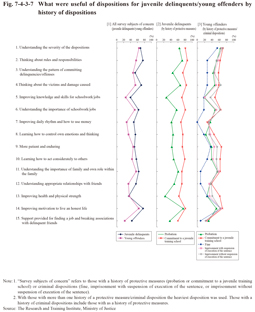4 Awareness of what were useful of receiving dispositions
Fig. 7-4-3-7 shows the answers (by multiple choice method) to the question of “what were useful of receiving a disposition” of juvenile delinquents/young offenders with a history of protective measures (excluding those with a history of commitment to a children’s self-reliance support facility, etc. only) or criminal dispositions by history of their dispositions.
First, examining the answers of all the survey subjects of concern (Fig. 7-4-3-7 [1]) revealed that juvenile delinquents considered receiving the dispositions helpful in “improving motivation to live an honest life” (76.2%), “thinking about rules and responsibilities” (75.8%), “thinking about the victims and damage caused” (71.0%), “understanding the severity of the dispositions” (68.7%), “understanding the importance of family” (63.5%), and “understanding the importance of schoolwork and jobs” (63.1%), etc. Fig. 7-4-3-7 [2] shows the answers of juvenile delinquents by history of their protective measures. Juvenile delinquents with a history of commitment to a juvenile training school considered receiving the disposition helpful in matters such as “thinking about rules and responsibilities” (86.1%), “thinking about victims and damage caused” (83.3%), “understanding the severity of the dispositions” (80.6%), “improving motivation to live an honest life” (80.6%), and “learning how to act considerately to others” (79.2%), etc., and those with a history of probation in “improving motivation to live an honest life” (74.4%), “thinking about rules and responsibilities” (71.7%), “thinking about victims and damage caused” (66.1%), “understanding the severity of the dispositions” (63.9%), and “understanding the importance of family” (60.6%), etc.
In contrast to this, young offenders (Fig. 7-4-3-7 [1]) considered receiving the dispositions helpful in “understanding the severity of the dispositions” (64.4%), “improving motivation to live an honest life” (63.7%), “understanding the importance of family” (56.2%), “thinking about rules and responsibilities” (56.2%), and “thinking about victims and damage caused” (53.9%), etc.. Next, examining the answers of young offenders by history of dispositions (Fig. 7-4-3-7 [3]) revealed that with both those with a history of probation and those with a history of commitment to a juvenile training school the proportion of those that answered “useful” to each selectable item was generally lower than with juvenile delinquents with the same protective measures histories, and thus the guidance through protective measures was considered not to have infiltrated into many of those that were imprisoned in penal institutions for committing offenses after receiving protective measures, and therefore the effect had not sunk in. In contrast to this, relatively many of those with a history of a criminal disposition of fine selected “improving motivation to live an honest life” (63.6%) and “understanding the severity of the dispositions” (54.5%) but the selection rate of the other items was low, thus indicating the disposition had little effect on them. Those with a history of imprisonment with suspension of execution of the sentence selected “understanding the severity of the dispositions” (66.0%), “improving motivation to live an honest life” (65.0%), “understanding the importance of family” (59.2%), “thinking about rules and responsibilities” (57.3%), and “understanding the importance of schoolwork and jobs” (51.9%), etc., and those with a history of imprisonment without suspension of execution of the sentence selected “understanding the severity of the dispositions” (68.9%), “thinking about victims and damage caused” (63.9%), “understanding the importance of schoolwork and jobs” (62.3%), “improving motivation to live an honest life” (62.3%), and “more patient and enduring” (54.1%), etc.
The proportion of those with a history of commitment to a children’s self-reliance support facility, etc (limited to those with a history of other dispositions; nine juvenile delinquents and 22 young offenders) that selected “improving knowledge and skills for schoolwork and jobs” as being helpful was remarkably high with both juvenile delinquents (77.8% and 38.3% with those without the said history) and young offenders (68.2% and 22.7% (id.)), thus indicating that the disposition made an opportunity to improve their knowledge and skills for schoolwork/jobs. In addition, many young offenders selected “improving health and physical strength” (72.7% and 33.6 (id.)), thus indicating that the disposition also made an opportunity to correct a disorderly life attitude.
In general, over half of the survey subjects displayed changes in their attitudes as their motivation to rehabilitate themselves had improved, their attitude toward social rules and their victims had improved, and they had become more aware of the importance of their families, schoolwork, and jobs, etc. The selection rate with regard to the dispositions being useful was higher with juvenile delinquents than with young offenders. In addition, those that regarded the dispositions useful with regard to knowledge/skills for schoolwork/jobs were rather few with both juvenile delinquents and young offenders while those that regarded dispositions useful in life management, self-control, and friend relationships few with young offenders, thus indicating that treatment concerning these matters needs to be further improved.
Fig. 7-4-3-7 What were useful of dispositions for juvenile delinquents/young offenders by history of dispositions
